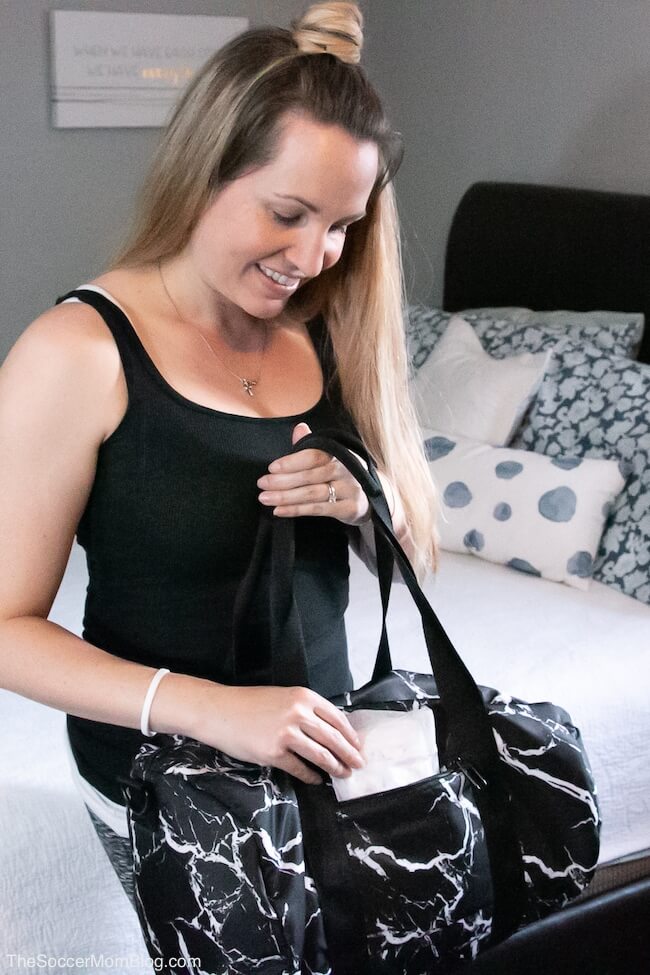Inside: How to strengthen pelvic floor muscles after childbirth and reduce related postpartum side effects such as light bladder leaks. I was asked by Carusele to participate in this campaign, sponsored by Prevail® Bladder Control Pads. Although I have been compensated, all opinions are my own.
What Are Your Pelvic Floor Muscles?
Your pelvic floor muscles are what keeps everything in place in your lower abdomen. They support your bladder, bowel, and womb.1
During pregnancy, the growing baby presses down on your pelvic floor muscles, stretching them. Sometimes they stretch too much or become weakened, which may lead to side effects such as bladder leaks for about three to six months postpartum. Postpartum bladder leakage is fairly common, affecting over 7 million women in the United States.2
The good news is that in many cases, you can stop bladder leakage on your own by re-strengthening your pelvic floor muscles. In the meantime, you can stay dry with protective hygiene products such as Prevail® Bladder Control Pads.
How to Protect Against Bladder Leaks While Your Body Heals
Your best bet is to use products that are specifically designed for bladder leaks, as opposed to other types of pads. Prevail Pads are 10 times more effective at trapping wetness than the leading period pad.*
But even then, all bladder leakage pads are not created equal!
Prevail pads absorb over 30% more wetness than both Poise and Always Discreet.* That’s because Prevail pads feature MaxSorb™ Gel, which actively locks up wetness to help you feel cleaner, fresher, and drier.
Plus, Prevail pads are individually wrapped so they’re both convenient and discreet.
Bladder leaks are inconvenient, but Prevail worked with both healthcare professionals and people living with leakage to create the best products possible to keep you feeling dry, comfortable, and confident.
*based on retention capacity
**based on retention capacity of the leading bladder control pads
Click here to learn more about Prevail products!
How to Strengthen Pelvic Floor Muscles
The best way to strengthen pelvic floor muscles is with targeted exercise. These pelvic floor exercises for women can be done during and after pregnancy.
Starting these exercises while pregnant may help prevent side effects like bladder leaks later after delivery. While I ended up delivering both of my daughters via c-section, I did attempt a VBAC, so my pelvic floor muscles took a beating! I truly believe that making a dedicated effort to keep my pelvic floor strong throughout my pregnancy helped to lessen side effects and speed up my healing process.
Pelvic Floor Exercises for Women
The two simple pelvic floor exercises that I used and recommended are pelvic floor squeezes and a yoga breathing technique called Kapalabhati Breath.
1. Pelvic Floor Muscle Squeezes
Also known as Kegel exercises, this technique involves isolating and contracting the pelvic floor muscles.
To do so, imagine that you’re squeezing as if you’re trying to “hold it” when you need to use the restroom. (Except in this case you don’t actually have to go).
When you’ve found your pelvic floor muscles, squeeze and hold for 3 three seconds, then release. Repeat this 10-15 times twice a day.
When practicing Kegel exercises, it’s important not to hold your breath or tighten the muscles in your abdomen or thighs. The focus is all on your pelvic floor muscles.
The great thing about Kegels is that you can do them anytime, anywhere and no one can tell! They can be done before, during, and after pregnancy to help strengthen pelvic floor muscles.
2. Kapalabhati Breath
Kapalabhati (kah-pah-lah-BAH-tee)3 Breath is a breathing technique practiced at the end of the traditional hot yoga sequence.
In Kapalabhati Breath, you alternate between short inhales and forceful exhales. These exhales are centered in your lower abdomen, essentially you “snap” your lower belly inward towards the back of your spine.
The easiest way to practice Kapalabhati Breath is in a comfortable seated position. I find it helpful to place my hands on my belly so I can feel the exhales and make sure I’m using the correct muscles. I also envision my core tightening inwards.
Inhales will happen naturally, and on the exhale, you want to push the air out quickly, making a “shhhh” sound. As you do so, pull your lower abdomen inwards, but do not tighten any other part of your body.
Here is a standing side view so you can get a good look at how the belly should curve inwards:
I especially love Kapalabhati Breath because it is helpful for healing diastasis recti too!
Have you tried any of the above ideas to strengthen your pelvic floor? I’d love to hear your tips in the comments below!
Click here to save 30% off Prevail® products on Amazon with code “30PREVAIL”
Click here to learn about how Prevail products can help you feel clean, confident, and fresh throughout your postpartum journey!
SOURCES
- “Leaking Pee After Having a Baby.” Continence Foundation of Australia, 2010. http://www.bladderbowel.gov.au/assets/doc/atsi/009_Leaking%20pee%20after%20having%20a%20baby.html
- Schlosberg, Suzanne, and Tracey Zemitis. “Your Guide to Urinary Incontinence After Childbirth.” Parents, 24 October 2018. https://www.parents.com/pregnancy/my-body/postpartum/urinary-incontinence/.
- “Skull Shining Breath.” Yoga Journal, 28 August 2007. https://www.yogajournal.com/poses/skull-shining-breath
I was asked by Carusele to participate in this campaign, sponsored by Prevail. Although I have been compensated, all opinions are my own.
More of our most popular posts about postpartum recovery:
How to Relieve Itchy Skin After Pregnancy
How to Stop Postpartum Hair Loss
- Paper Chain Octopus Craft - April 24, 2024
- Amish Sugar Cookies - April 19, 2024
- Marshmallow Playdough - April 18, 2024









Leave a Reply